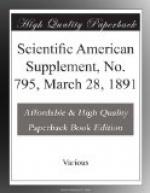In the first place, for every 478.5 cubic feet of hydrogen made under perfect theoretical conditions never likely to be obtained in practice, 56 lb. of iron were converted into the magnetic oxide, and as there was no ready sale for this article, this alone would prevent its being used as a cheap source of hydrogen; the next point was that when steam was passed over the red-hot iron, the temperature was so rapidly lowered that the generation of gas could only go on for a very short period, while, finally, the swelling of the mass in the retort and fusion of some of the magnetic oxide into the side renders the removal of the spent material almost an impossibility. These difficulties can, however, be got over. Take a fire clay retort, six feet long and a foot in diameter, and cap it with a casting bearing two outlet tubes closed by screw valves, while a similar tube leads from the bottom of the retort. Inclose this retort by a furnace chamber of iron lined with fire brick, leaving a space of two feet six inches round the retort, and connect the top of the furnace chamber with one opening at the top of the upright retort, while air blasts lead into the bottom of the furnace chamber, below rocking fire bars, which start at bottom of the retort, and slope upward, to leave room for ash holes closed by gas tight covers. The retort is filled with iron or steel borings, alone if pure hydrogen is required, or cast into balls with pitch if a little carbon monoxide is not a drawback, as in foundry work. The furnace chamber is now filled with coke, fed in through manholes, or hoppers, in the top, and the fuel being ignited, the blast is turned on, and the mixture of nitrogen and carbon monoxide passes over the iron, heating it to a red heat, while the fuel in contact with the retort does the same thing.
When the fuel and retort full of iron are at a cherry-red heat, the air blast is cut off, and the pipe connecting the furnace and retort, together with the pipe in connection with the bottom of the retort, are closed, and steam, superheated by passing through a pipe led round the retort or interior wall of the furnace, is injected at the bottom of the red-hot mass of iron, which decomposes it, forming magnetic oxide of iron and hydrogen, which escapes by the second tube at the top of the retort, and is led away either to a carbureting chamber if required for illumination, or direct to the gasholder if wanted as a fuel. The mass of incandescent fuel in the furnace chamber, surrounding the retort, keeping up the temperature of retort and iron sufficiently long to enable the decomposition to be completed.
The hydrogen and steam valves are now closed and the air blast turned on. The hot carbon monoxide passing over the hot magnetic oxide quickly reduces it down to metallic iron, which, being in a spongy condition, acts more freely on the steam during later makes than it did at first, and being infusible at the temperature employed, may be used for a practically unlimited period.




